Are you wondering how rainbows are formed?
Rainbows are perhaps fascinating shows of nature. It’s not a “thing,” nor does it occur in a specific “place.” A rainbow is something like a visual illusion that is not in control by living creatures and rainbows is formed when sunshine and ambient conditions are just right, as is the viewer’s place to see it.
A rainbow formed due to the connection between sunshine, water, and air, which is why it is more apparent when the day is bright and gloomy. The creation of a rainbow requires a physical process, including dispersion, refraction, reflection, and absolute internal reflections.
The Rainbow is formed because of sunlight and ambient conditions. Light reaches the water droplet, speeds down, and bends as it passes from air to water, which is heavier. The light reflects within the droplet that divides the wavelengths or colors of its component. When the light falls out of the droplet, it produces a rainbow. This occurs as the sun’s rays make contact with the water droplet at a certain angle.
The Direction of Light With a Droplet
The array of condensed water droplets in the atmosphere acts as a reflector of light. Water is a medium of a multiple optical densities from the surrounding air. Light waves refract as they cross the transition from one source to another. The reduction in speed as the light reaches the water droplet allows light to curve to ordinary. And when the droplet is gone, the light speeds up and angles away from the normal. The droplet allows the direction of light to deviate as it approaches and leaves the drop.
Rainbow formation path
There are innumerable pathways through which the sun rays will travel through a decline. Each direction is a guide by a bending towards and away from the normal. One of the directions of considerable importance in the discussion of rainbows is the direction in which light refracts through the droplet, internally reflects, and then scatters out of the drop of water.
The sun’s light ray reaches the droplet in a gentle downward direction. When refracting twice and absorbing once, the light ray is scattered and angled down towards the viewer on the planet’s surface.
Other entry positions in the drop of water may result in identical pathways or light proceeding through the drop of water and the opposite end without substantial internal reflection. However, for the entry position seen in the diagram below, an ideal concentration of light escapes the airborne droplet at an angle to the earth. (Zolpidem)
As in the refracted light by prisms with non-parallel sides, the refraction of light at two ends of a drop of water results in light scattering through a continuum of colors. The short wavelength of blue and violet light is significantly bigger than the higher wavelength of red light.
Although the borders are non-parallel to each other, a double refraction results in a distinct distinction of the illumination from its constituent colors.
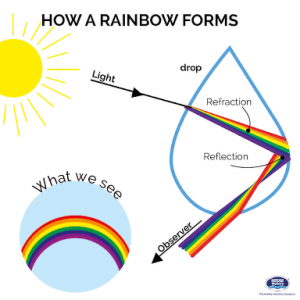
Angle of Deviation
The angle of deviation between the incoming sunlight rays and the refractory rays orient to the observer’s eyes is roughly 42 degrees for the red light. Owing to the inclination of the wavelengths shorter of blue light to reflect rather than red light, the divergence angle from the initial sun rays is about 40 degrees.
If seen in the diagram, the red light refracts from the droplet at a higher elevation to the earth’s observer. There are multiple paths through which the ray will travel through a drop of water and then the earth’s angle.
Some pathways depend on which part of the drop of water the incident rays come into contact with. The maximum concentration of outgoing rays is visible at these angles of deviation of 40-42 degrees. The scattered light is bright enough to create a rainbow that appeared in the sky at these angles.
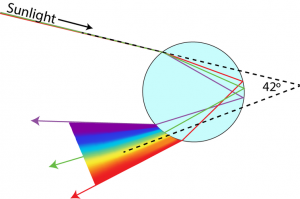
Now that we grasp the direction of light through a single droplet, we can discuss the subject of how rainbows are formed.
How are rainbows formed?
The rainbow is most commonly appears as a curve path in the sky. A person on the ground sees a half-circle of color with a red color seen outside the Rainbow’s peak. People lucky enough to see this from a plane flying may know that a rainbow may literally be a full circle.
Spectators on the ground are just gazing at the upper half of the circle because the lower half of the complete circle stops by the ground’s existence. Yet spectators in a flying plane will also look up and down to see the full circular rainbow.
The rainbow circle benefits from the fact that there is a series of trapped droplets in the environment capable of focusing the scattered light at a deviation angle of 42 degrees relative to the initial sunlight direction. In reality, these raindrops form circular arcs, with each drop of water in the arc displacing the light and reflecting it straight to the observer.
Any droplet within the arc is refracting and displacing the entire visible range of light. The red light refracts from the droplet at higher angles to the surface than the blue light.
Thus, whenever an individual aims at a higher elevation concerning the earth, the droplets along this line of sight refractive the red light to the spectator’s retina.
The blue ray from these same raindrops is visible at a less steep angle and appears along a direction that crosses over the observer’s head.
Different types of Rainbow
Rainbows are of various types. Some of the different forms of rainbows are:
Double Rainbows
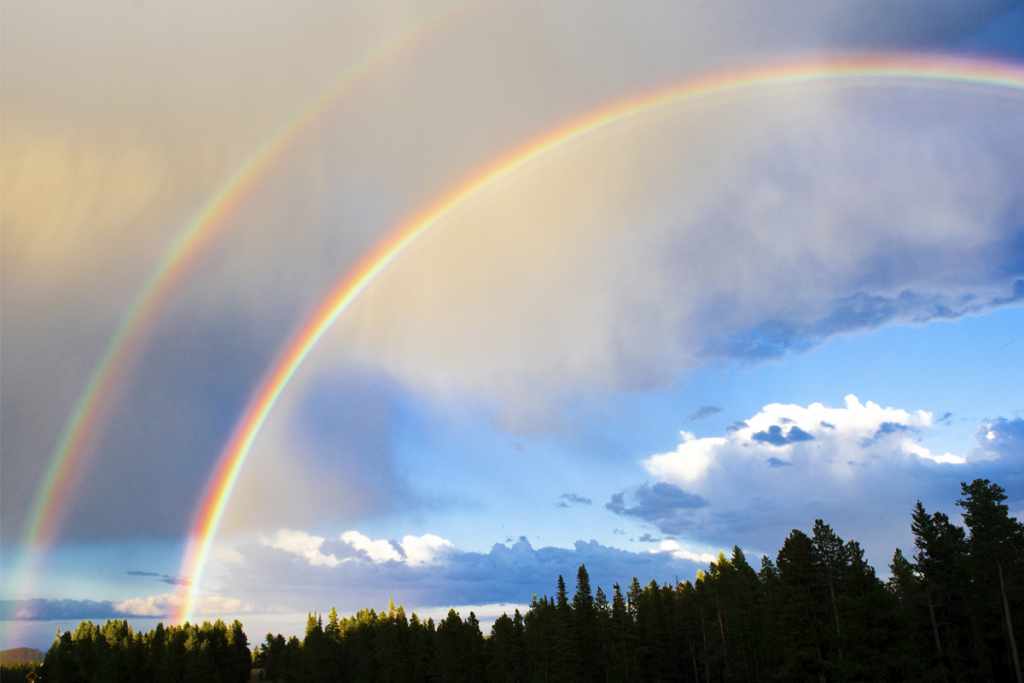
Double rainbows are formed where a second rainbow is apparent above the original rainbow. This illusion by a double mirror allows the hue order of the second rainbow to invert.
Moonbow’s
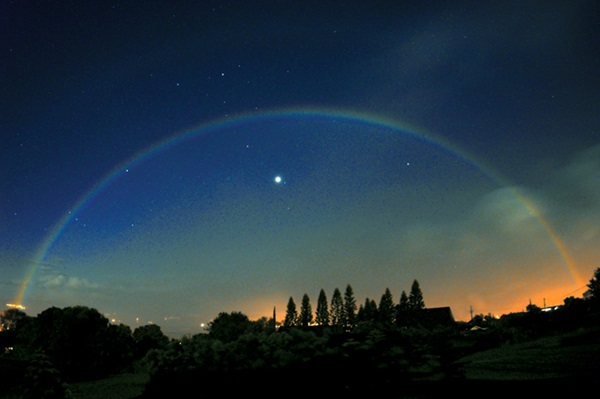
While most rainbows forms with interaction with sunlight that happens directly after a rainstorm, certain rainbows form by the moonlight. Moonbows are less frequent than rainbows in the daytime.
These visions can only be visible in certain parts of the world, usually near waterfalls. Moonbows are also visible at the bottom of such falls. Also, moonbows typically need full moonlight to be visible. Many people see the moonbows as absolutely white.
Fogbow’s

Like moon rainbows that formed in waterfall spray, fogbows can be seen in thin fog cases mixed with significant sunshine. In this case, the light reflects a thick array of water crystals, resulting in a large and vivid rainbow.
Fogbows are nearly entirely light in color. This white presence happens because any light wave is visible over a vast field. These large stripes appear to mix, forming a white hue. However, red and blue color lines can also be seen near the sides of the fogbow.
Reflected Rainbows
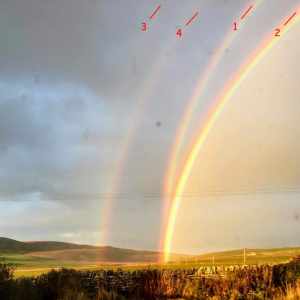
A reflected rainbow is identical to a visible rainbow in that it appears over a massive body of still water. At the same time, some persons have reported seeing reflected rainbows in small still water sets.
The distinction between these rainbows is that the projection does not appear in the atmosphere but on the ocean surface. These rainbows are formed as light waves travel through raindrops in the environment and are mirrored in the water surface.
Monochrome Rainbows

As the names imply, a monochrome rainbow has a solid hue rather than an entire range typical of rainbows. This illusion is the product of a strong red rainbow. These rainbows are formed after precipitation near sunset or sunrise. In these periods, sunlight moves further into the environment, allowing green and blue light waves to scatter over a larger area, and without these colors, red light waves will overtake the sky. Monochrome rainbows are an uncommon occurrence.





